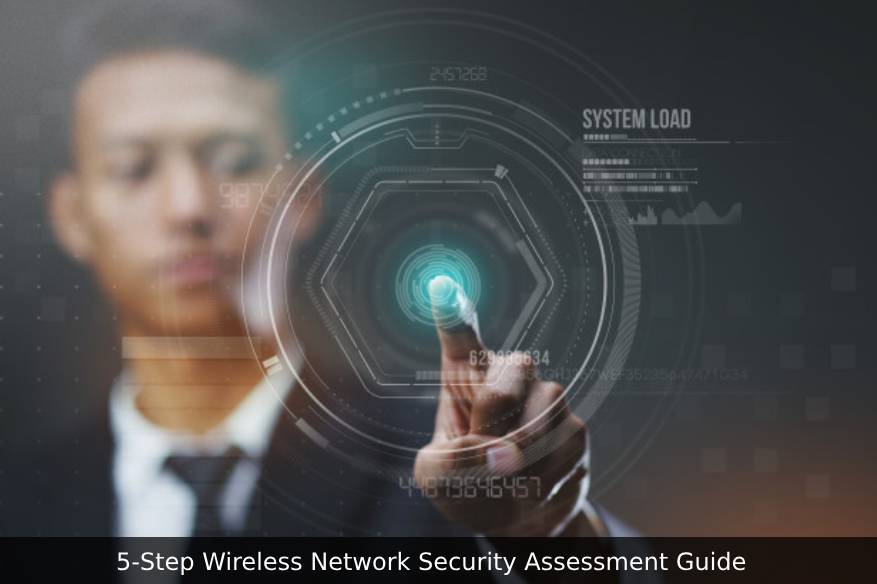Wireless Network Security Assessment Guide | 5 Step Assessment

Wireless network security is an ongoing process and you’ve got to be continually on alert since unauthorized people, including cybercriminals, can sneak into your network without even been detected and cause you much harm by sabotaging your network, stealing your data, hijacking and altering communications etc. Thus, keeping your WLAN secure is of utmost importance. You must, in order to ensure comprehensive wireless network security, also perform regular vulnerability assessment, which would help you to identify and patch vulnerabilities at the earliest, thereby preventing cybersecurity attacks on your network.
WLAN vulnerability assessment – it’s almost akin viewing your wireless network from the perspective of an outsider. Since outsiders include the bad guys as well, looking at the network from an outsider’s perspective could help you understand if there is any easy way to make an entry, any vulnerability that could let unauthorized devices attach themselves to the network and do mischief with your network security and data security. You can plug the holes that you thus detect, on time to save yourself from cyberattacks.
Here’s an easy, 5 step wireless network security assessment guide that could help you in identifying security vulnerabilities and staying secure…
Step 1: Identify and know wireless devices accessing your network
You must know what all devices access your network. You also need to know everything about each such device, including laptops, mobile devices, wireless routers and WAPs (Wireless Access Points). Document all the data that you collect from your scanner, which would be examining all active traffic in your wireless network and through all wireless devices connected. You must document everything about each device – all details including details regarding the owner, the location of the device etc. This would give you a clear picture of your network, all the devices connected to it and hence you’d be able to keep tabs on things in a more perfect manner.
Step 2: Detect rogue devices, if any
You should always stay alert of rogue devices, i.e., devices that should ideally not be there on your network but continue to be there. Such rogue devices could prove to be great security hazards and hence you need to tackle them effectively and promptly. You can detect rogue devices very easily. All you have to do is take the list of devices that you find accessing your network (as already mentioned in Step 1) and compare it to the inventory of devices that you have with you. This helps discover rogue devices, which you could block instantly to avoid security issues. You could also use your network vulnerability scanner to check for activities on channels/wireless bands that you are not using.
Step 3: Check, secure your WAPs
The WAPs on your network need to be secure, as secure as any device that accesses your wireless network. Remember, a WAP that has security holes could provide an easy entry to any outsider, including hackers and hence it’s important that all WAPs have the latest security patches and firmware installed. You must also change the default password and opt to have a strong password, and must also configure the WAP to use the most secure options and to send alerts whenever there’s any kind of an issue.
Step 4: Keep updating your device inventory, check new devices
You need to keep updating your device inventory regularly to include new devices- desktops, laptops, smartphones, tablets, VoIP phones etc- that are newly added to your wireless network or which are approved to access your network even from remote locations. You must also, from time to time, do comprehensive checks on all such devices, to find out if they have all security vulnerabilities patched, if all software on each of these devices are updated on time and also to find if they are running the most current OS. You also need to ensure that these devices are equipped with all the security software that they need to have, based on the functions that they perform and such other things. You must ensure that all such devices adhere to and are configures in accordance with the security policy of your organization.
Step 5: Act immediately, plug all holes
If your vulnerability scanner detects any security issues, you must act immediately and do all that is needed to plug the security holes. Any security patch that’s missing should be installed, passwords should be reset and software should be updated, if it’s due and not yet done.
Points to remember
- Have a checklist, ensure you’ve done all that’s needed.
- Always test your fixes, make sure all security holes are closed.
- Once you’re done, mark your calendar for the next wireless network security assessment.
- Always choose the best network vulnerability scanner application to perform the security assessment.
Source: https://blogs.cisco.com/smallbusiness/5-steps-for-assessing-your-wireless-network-security
Related Resources:
Tips for Achieving Network Security